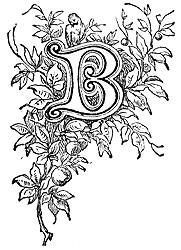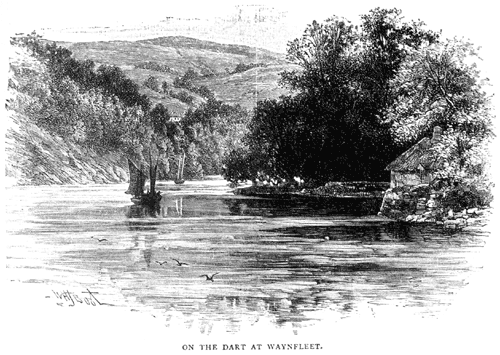 |

EAUTIFUL excedingly is South Devon, with its hills and moors, and its proverbially long lanes. It is a land of flowers too; the soft mild humid air suits even such hothouse plants as the azalea, which here grows to the size of a shrub.
How lovely those long lanes are, sunk in the hills! Tradition says that they were thus cut to hide the wain going home with its treasures, from the greedy eyes of Saxon freebooters. But now, trees bending from each hillside meet overhead, and wild honeysuckles and roses, entangled, droop from them; while on the ground and in every coign of vantage spread the round green leaves that children call "pennies," and the foxglove, the meadow-sweet, and other wild flowers grow. The ferns are peculiarly beautiful and very varied, growing on every bank, and waving their graceful fronds at every opening where the sky shows through the greenery, and we can trace their delicate outline against the light.
The ferns of Devon are, in fact, one of its features. The Rev. T. Ravenshaw, in his "List of the Flowering Plants and Ferns growing wild in the County of Devon," enumerates forty different ferns and fern allies. There are also in Devonshire more than 700 species and varieties of fungi, some beautiful in form and colour. The botanist will also find many rare plants in the hedge banks or meadows; and the naturalist will find a rich variety of birds and woodland animals. We have seen in a hedgerow, constantly passed, though in private grounds, the great hole of a badger; this animal is numerous on the borders of Dartmoor.
The rivers of South Devon run also remarkably picturesque courses.
Dartmoor has been called the land of streams, and one of the loveliest of them is the Dart. It rises in Cranmere Pool, a morass on the northern margin of Dartmoor, between Okehampton and Crockern Tor. This morass is on the top of a hill never known to be dry, and full of dangerous bogs.
Dartmouth is one of the most picturesque havens in England. The waves of the British Channel spread wide and grand before the harbour, in which, at the mouth of the Dart, are moored the training ships Britannia and Hindostan, where the young officers of the Royal Navy are educated for their profession. And up the south side of a very steep hill, that runs east and west for nearly a mile, the houses of the town are built. "Whereby," the antiquary Prince writes, "the houses, as you pass on the water, seem pensile, and hang along in rows like galley pots in an apothecary's shop" - not by any means a pleasant or very apt description; yet, from the sea the houses still seem almost suspended. The hill to the left is embosomed in rich masses of trees. A little higher up again, to the left, Old Mill Creek runs for some distance by the side of lovely woods.
Dartmouth Castle stands on a point of land close to the sea. It has two towers; the circular one dates from the reign of Henry VIII. Opposite to it is Kingswear Castle, now restored and inhabited.
Many old memories hang about Dartmouth harbour. It was here that Richard Coeur de Lion mustered his fleet for the Crusade; from thence, in 1347, a large armament sailed under Edward III. for Calais. In 1377 the town was plundered and partly burnt by the French, and from hence - a far pleasanter recollection - sailed the Pilgrim Fathers in the Speedwell and Mayflower, to found a new empire of Englishmen in a new world.
On the right, as we steam up the river, on an eminence, we see Greenway House, once a dwelling of Sir Walter Raleigh's, where he is said to have alarmed his servant by smoking a pipe. The first po tato, that most valuable gift that he be stowed on England, was planted here. It is still more interesting to learn that GreenWay was the birthplace of Sir Humphrey Gilbert, the half-brother of Raleigh. He took possession of Newfoundland in Elizabeth's reign, and was lost in a storm. The last time his comrades saw him, before he disappeared from their sight for ever, in the mist and gloom of the evening, he held a Bible in his hand, and said cheerily, "We are as near heaven by sea as by land."
Just abreast of Greenway is a rock that rises from the bed of the river, and it is under water at high tide. As a vessel once struck on it, an iron beacon has been placed on it to show the danger when it is covered. It was formerly called the "Scold's stone,"a scolding wife being placed on it as a punishment by the men of Dittisham. She must have been in considerable peril at high water, unless released before the tide flowed. Plum trees grow in great abundance at the village of Little Dittisham, and the narrow and steep village road, winding up the hill, can be traced by cottage roofs between the trees. The rectory is buried in the thick foliage; above it rises "Fire Beacon Hill," 600 feet high, and therefore well adapted to give the signal of danger and invasion. The tower of the church rises above the hill, and on this spot is found one of the loveliest pictures on the beautiful river.
 As the steamer rounds Gora Point, we pass several mansions, surrounded by trees. Further on we come to Sandridge, an Italian villa, built by the first Lord Ashburton.
Here John Davis, the Arctic explorer, was born. He sailed from Dartmouth in the little Sunshine (50 tons), and her small comrade, the Moonshine, in June, 1575, and discovered the passage that bears his name, between Greenland and North America.
By-and-by we get a glimpse of Higher Dittisham Church and the pretty cottages among the damson groves. This part of the river is called Long Stream. Then comes the picturesque village of Stoke Gabriel, in an amphitheatre of woods, sloping to the stream, with the ivy-covered tower of the Church of St. Gabriel, and the fishing cottages gathered round it. A very old and large yew tree stands in this churchyard.
After leaving the few houses of the pretty hamlet of Duncannon, we reach the most picturesque part of the river - the woods of Sharpham, that make a fine semicircular sweep on our left. The whole of this hill is covered with the foliage of magnificent old trees; the woods sweep down to the river, and dip their branches in the stream. Nothing can exceed the lovely tints that paint these woods in autumn; their richness, massiveness, and closeness to the river, make them a wonderful picture of sylvan beauty. Towards the end of them we come on a tasteful boathouse, and just below is the Bass rock, so named from the fine fish of that name caught here.
We think that the Dart here loses in a degree its picturesqueness, and we shall therefore bid it adieu. It will be long, however, ere its sparkling waters and overhanging woods will pass from our remembrance, and when a lovely river is mentioned, we shall think of the Dart.
|
 |